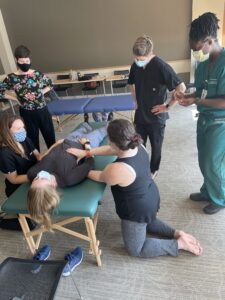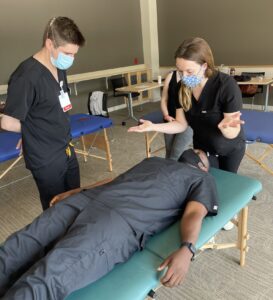Beginning with first-year orientation, our osteopathic resident physicians are trained in osteopathic structural examinations, manipulative treatment, and documentation so they can begin their clinical osteopathic practice. We follow a three-year curriculum that aims to graduate osteopathic residents who are prepared to provide manipulative medicine as part of their family practice. During monthly didactic sessions with osteopathic faculty, topics and techniques are introduced to foster the osteopathic resident’s ability to evaluate and treat across all clinical settings.
Osteopathy Integrated into the Outpatient Practice
Under the supervision of precepting osteopathic physicians, residents are provided the opportunity to gain additional hands-on guidance and experience. Our osteopathic residents have osteopathic manipulative treatment (OMT) appointments fully integrated into their clinic experience. In addition to providing manipulative treatment to their own patients, osteopathic residents may deliver OMT to patients referred by other providers.
Inpatient OMT
Osteopathic residents are expected to perform and document structural exams as part of the inpatient history and physical. In concert with our rounding osteopathic faculty and inpatient osteopathic neuromusculoskeletal medicine (ONMM) team consisting of Maine-Dartmouth ONMM faculty and ONMM residents, family medicine residents learn the value of osteopathic techniques in the inpatient setting, including treating newborns. Bedside rounds offer resident physicians another opportunity for osteopathic treatment and teaching.
At Maine-Dartmouth we strive to serve our community with the practice of preventative and integrative family medicine. Allopathic residents are therefore exposed to osteopathic philosophy and practice during monthly osteopathic education sessions. This allows our MD resident physicians to develop basic hands-on diagnostic and therapeutic skills, as well as to knowledgeably interact with their DO colleagues and make appropriate ONMM referrals.


